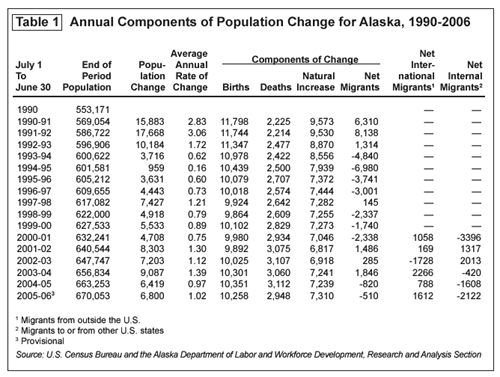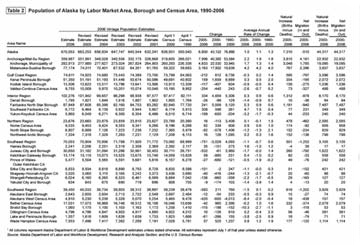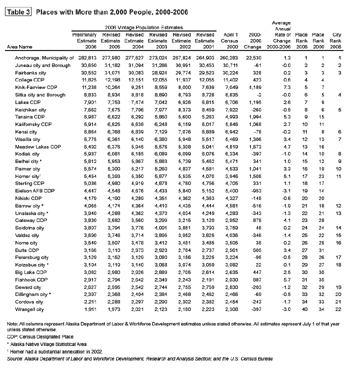 No longterm growth in Southeast January 25, 2007
The Alaska Department of Labor and Workforce Development utilized the federal figures to calculate growth estimates released today for the state and by boroughs, census areas and places. The State of Alaska The population gain in Alaska was slightly faster than the 5.9 percent growth in the same period for the United States as a whole. The number of people living in the state climbed from 627,533 at the time of the July 1, 2000, to a provisional July 1, 2006, estimate of 670,053 (see Table 1).  Table 1: Click on chart to view a larger image.
Currently growth in Alaska as a whole is primarily through natural increase. From July 1, 2000, to July 1, 2006, Alaska's natural increase (births minus deaths) added 42,571 people, while net migration (in-migration minus out-migration) accounted for a loss of 51 people. During 2005-2006, Alaska added 7,310 people through natural increase and lost 510 people to out-migration. In the early 1990s, Alaska added about 9,600 people each year through natural increase. A gradual decline in fertility and a gradual increase in mortality tied to an aging population have resulted in a slowdown in natural increase to about 7,300 persons per year. Table 1 Annual Components of Population Change for Alaska, 1990-2006 When international and domestic migration are considered, the loss of 512 migrants between 2005 and 2006 breaks down into a gain of 1,612 international migrants and a loss of 2,122 domestic migrants. International migration is currently compensating for some of the outward domestic migration. Currently, about 35,000 persons migrate to and from Alaska each year. In and out migration, however, are nearly equal. "It is important to note that, because these estimates are for resident population, any troops deployed overseas are counted as being in Alaska." said Greg Williams, state demographer. Williams added, "This means that the populations for the Fairbanks North Star Borough and the Municipality of Anchorage, where the main Alaska military bases are located, or other communities with substantial National Guard, may fluctuate somewhat lower or higher depending on the current movement of military and National Guard personnel." Boroughs and Census Areas State labor department population estimates have also been released for Alaska's 27 boroughs and census areas, and also for 347 occupied places throughout the state. (See Table 2). This table, unlike Table 1, considers population change from April 1, 2000, as opposed to July 1, 2000. Most of Alaska's boroughs and census areas have grown slowly or lost population between April 1, 2000 and July 1, 2006. The largest population increases have occurred in the Municipality of Anchorage (+22,530), Matanuska- Susitna Borough (+17,852), Fairbanks North Star Borough (+5,009), Kenai Peninsula Borough (+1,659), Bethel Census Area (+985), Southeast Fairbanks (+598), and Wade Hampton Census Area (+525).
Of the 27 boroughs and census areas, only nine gained population in the 2000-2006 period. Population growth in the Municipality of Anchorage and the Matanuska-Susitna Borough accounted for roughly 81 percent of the growth in these nine boroughs and census areas. The Municipality of Anchorage made up 45 percent of the growth, with population gains in the Matanuska- Susitna Borough making up 36 percent. The Matanuska-Susitna Borough remains the fastest growing area of the state, as it has been since 1990. In the 2000-2006 period, it grew at an average annual rate of 4.2 percent, compared to its 4.0 percent annual growth rate during the 1990s. The increases in both the Municipality of Anchorage and the Matanuska-Susitna Borough in the 2000-2006 period were due to a mix of natural increase and migration. A substantial part of migration to Anchorage (a net gain of 3,435 people) comes from other parts of Alaska. The Matanuska-Susitna Borough was the only area of the state where growth came primarily from net in-migration. Since the 2000 Census, in-migration accounted for 14,015 of the Matanuska-Susitna Borough's population increase of 17,852. The majority of Matanuska-Susitna migration comes from the Municipality of Anchorage. These two areas, plus the Southeast Fairbanks Census Area, were the only areas where in-migration exceeded out-migration over the 2000-2006 period. In the more recent 2005-2006 period, Anchorage gained 4,833 people, while the Matanuska-Susitna Borough gained 3,163 people. While Anchorage had a current natural increase of 3,048 compared to the Matanuska- Susitna Borough's 767, Mat-Su gained 2,396 migrants while Anchorage gained 1,785. All other boroughs and census
areas lost population to out-migration or remained unchanged
between 2000 and 2006. The Southeast region continued to have
the largest overall decline, with a natural increase of 3,105
people and a net out-migration of 6,134 people. No area of Southeast
had long term growth between 2000 In the 2005-2006 period, only Haines Borough (+35) and Ketchikan Gateway Borough (+59) had slight gains. In all areas of Southeast except Haines, out-migration was greater than natural increase. Between 2000 and 2006, migration out of Southwestern Alaska (-3,718) was less than the natural increase in this region (+3,929). Most of Southwest's loss was accounted for by the Bethel Census Area. In every other area of Southwest, out-migration exceeded natural increase. In the Northern region, the natural increase (+2,585) failed to keep up with out-migration (-2,698). In the Gulf Coast region, the natural increase (+3,596) kept ahead of out-migration (-2,784). The Kodiak Island Borough had more net out-migration (-1,443) than natural increase (+1036) and the Valdez- Cordova Census Area population declined as natural increase (+488) failed to match net out-migration (-928). The Kenai Peninsula Borough grew mainly through natural increase (+2,072) as opposed to net migration (-413). During the more recent 2005-2006 period, Valdez-Cordova Census Area and Kodiak Island Borough declined as out-migration exceeded natural increase. In the Kenai Peninsula Borough, however, natural increase (+354) exceeded out-migration (-195) for a slight population increase. In the Interior, the Fairbanks North Star Borough (+5,009) and the Southeast Fairbanks Census Area (+598) grew in the 2000-2006 period, largely due to natural increase. The Yukon-Koyukuk Census Area (-650) and Denali Borough (-98) shrank as out-migration exceeded natural increase. During the 2005-2006 period, the Fairbanks North Star Borough grew only slightly (+241) as did the Southeast Fairbanks Census Area (+308). In the Fairbanks North Star Borough natural increase barely kept up with out migration. Southeast Fairbanks gained as a result of both natural increase and in-migration. Places Alaska had 35 places with populations of more than 2,000 in the year 2000 (see Table 3); 22 of them are incorporated cities or city-boroughs. Thirty-two places in Alaska have populations of more than 2,500, the old U.S. Census Bureau defi nition of urban place. The Municipality of Anchorage continues to dominate the state. Its population of 282,813 in 2006 accounts for 42.2 percent of the state's population, up slightly from 41.5 percent in 2000; the Anchorage/Mat-Su region (359,987) accounts for 53.7 percent of the population, up from 50.1 percent in 2000. The places with populations greater than 2,000 that have had the highest average annual growth rates since the 2000 Census include the Knik-Fairview Census Designated Place (CDP) (+7.3 percent), Fishhook CDP (+5.7), Tanaina CDP (+5.3), Homer city (+5.1), Meadow Lakes CDP (+4.7), Gateway CDP (+4.1), Butte CDP (+3.4), Wasilla city (+3.4), Palmer city (+3.3), Kalifornsky CDP (+2.7), Lakes CDP (+2.6) and Big Lake CDP (+2.5). All but two of the top 12 places that experienced the most rapid growth in the 2000-2006 period are in the Matanuska- Susitna Borough. "Indeed, if they were to incorporate, six places in the Matanuska-Susitna Borough would be larger than the cities of Wasilla and Palmer, and Knik-Fairview would become the fi fth-largest city in the state," said Williams. "The remaining two rapidly growing places are Kalifornsky CDP and Homer city in the Kenai Peninsula Borough," Williams added. "However, Homer's growth is largely due to its annexation of a substantial part of Diamond Ridge CDP and Miller Landing CDP in 2002." "Outside of Anchorage/Mat-Su, a majority of communities are stagnant or declining," Williams said. "Six-teen of the 35 places that had more than 2,000 people in 2000 have declined. In fact, over half of the places in Alaska (181 or 52.2 percent) have had at least small losses of population since 2000." This includes four of the top 11 communities: Juneau city and borough, Sitka city and borough, Ketchikan city and Kenai city. The places that declined on average by more than 1.0 percent each year during the 2000-2006 period are Eielson Air Force Base CDP (-3.1 percent), Wrangell city (-3.0), Barrow city (-1.9), Cordova city (-1.7), Valdez city (-1.4), Unalaska city (-1.3), Seward city (-1.2) and Kodiak city (-1.0). Wrangell slipped below 2000 population in 2005.
Population estimates Research
and Analysis Web site Source of News:
Publish A Letter on SitNews Read Letters/Opinions
|
||

